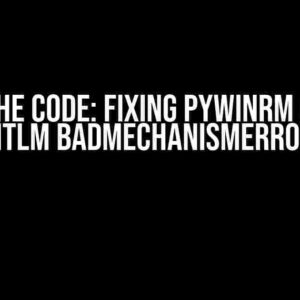If you’re a seasoned Python developer or a fledgling data scientist, you’ve likely encountered the frustration of running an update() method with parameters derived from a Pandas DataFrame’s to_dict() function. The promise of seamless data manipulation and aggregation is tantalizing, but the errors that arise can be a significant roadblock. Fear not, dear reader, for this article is here to guide you through the treacherous landscape of update() and df.to_dict() and emerge victorious on the other side.
The Problem: update() and df.to_dict()
When working with Pandas DataFrames, one common operation is updating specific rows or columns based on certain conditions. The update() method is an excellent tool for this task. However, when attempting to pass parameters derived from df.to_dict(), things can quickly go awry.
import pandas as pd
# Create a sample DataFrame
data = {'Name': ['Alice', 'Bob', 'Charlie'],
'Age': [25, 30, 35],
'Score': [90, 80, 70]}
df = pd.DataFrame(data)
# Convert DataFrame to dictionary
dict_data = df.to_dict('records')
# Attempt to update the DataFrame using dictionary values
for item in dict_data:
df.update({'Score': item['Score'] + 10})
The Errors: A Deeper Dive
Running the code above will result in an error, specifically a KeyError or a ValueError, depending on the specifics of your data. But why does this happen?
- KeyError: When you attempt to update a DataFrame with a dictionary, Pandas expects the dictionary keys to match the column names in the DataFrame. However, when using df.to_dict(‘records’), the resulting dictionary contains the index as a key, which doesn’t exist in the original DataFrame.
- ValueError: Even if you manage to circumvent the KeyError by using the correct column names, the update() method is designed to update entire columns or rows, not individual values. Passing a dictionary with multiple key-value pairs will raise a ValueError, as the method doesn’t know how to handle the multiple updates.
The Solutions: A Step-by-Step Guide
Now that we’ve identified the pitfalls, let’s explore the solutions to overcome them.
Solution 1: Using iterrows() and update() with caution
One approach is to use the iterrows() function, which returns an iterator over the rows of the DataFrame, along with their index. You can then update the DataFrame row by row, using the dictionary values.
for index, row in df.iterrows():
df.loc[index, 'Score'] = row['Score'] + 10
However, be cautious when using iterrows(), as it can be inefficient for large DataFrames. Additionally, this method updates the entire row, which might not be desirable if you only want to update specific columns.
Solution 2: Using apply() with a custom function
A more elegant solution is to use the apply() function, which applies a custom function to each row or column of the DataFrame. You can define a function that takes a dictionary as an argument and returns the updated values.
def update_score(row_dict):
return row_dict['Score'] + 10
df['Score'] = df.apply(lambda row: update_score(dict(row)), axis=1)
This approach is more flexible, as you can define a custom function to handle complex updates. However, it can still be slow for large DataFrames.
Solution 3: Vectorized operations for performance
For optimal performance, you can leverage Pandas’ vectorized operations to update the DataFrame in a single step.
df['Score'] += 10
This method is the most efficient, as it operates on the entire column at once. However, it requires a deep understanding of Pandas’ vectorized operations and might not be applicable to all scenarios.
Best Practices and Performance Considerations
When working with large DataFrames, it’s essential to consider performance implications. Here are some best practices to keep in mind:
- avoid using iterrows() and apply() whenever possible, as they can be slow and inefficient.
- opt for vectorized operations, which are designed to work with entire columns or rows at once.
- use the loc[] and iloc[] indexers, which provide efficient and flexible access to DataFrame rows and columns.
- profile and optimize your code, using tools like the built-in timeit module or external libraries like line_profiler.
Conclusion: Mastering update() with df.to_dict()
In conclusion, running an update() method with parameters from df.to_dict() can be a minefield, but with the right strategies and techniques, you can overcome the errors and achieve efficient data manipulation. By understanding the pitfalls and employing the solutions outlined in this article, you’ll be well-equipped to tackle even the most complex data transformations.
Remember to always consider performance implications and follow best practices to ensure your code is efficient, scalable, and maintainable. Happy coding!
| Solution | Performance | Complexity |
|---|---|---|
| iterrows() | Slow | Medium |
| apply() | Medium | High |
| Vectorized operations | Fast | Low |
By choosing the right approach for your specific use case, you’ll be able to conquer the challenges of running update() with parameters from df.to_dict() and unlock the full potential of Pandas DataFrames.
Here is the HTML code with 5 Questions and Answers about “Running an update() with parameters from df.to_dict() causes errors” in a creative voice and tone:
Frequently Asked Question
Stuck with pesky errors when trying to run an update with parameters from df.to_dict()? Fear not, friend! We’ve got the answers to get you back on track.
Why does running an update() with parameters from df.to_dict() cause errors in the first place?
When you use df.to_dict() to convert your Pandas DataFrame to a dictionary, it returns a dictionary of dictionaries, where each key is a column name and the value is another dictionary with the index as keys and the column values as values. However, when you try to use this dictionary as parameters for an update() function, it can cause errors because the update() function doesn’t know how to handle nested dictionaries.
How can I fix the error caused by running an update() with parameters from df.to_dict()?
One way to fix this error is to use the orient parameter in df.to_dict() and set it to ‘records’. This will return a list of dictionaries, where each dictionary represents a row in the DataFrame, with the column names as keys and the values as values. You can then use this list of dictionaries as parameters for your update() function.
What’s the difference between df.to_dict() and df.to_dict(orient=’records’)?
The main difference is the structure of the resulting dictionary. df.to_dict() returns a dictionary of dictionaries, while df.to_dict(orient=’records’) returns a list of dictionaries. The latter is often more suitable for use as parameters for an update() function, as it’s easier to iterate over and access the values.
Can I use df.to_dict() without the orient parameter and still make it work?
Yes, but it’s going to require some extra work! You can use df.to_dict() without the orient parameter, but you’ll need to flatten the resulting dictionary of dictionaries into a single-level dictionary. You can do this using a dictionary comprehension or the itertools.chain function. However, using df.to_dict(orient=’records’) is often a simpler and more straightforward solution.
Are there any other common pitfalls to watch out for when using df.to_dict() and update()?
One common pitfall is making sure that the column names in your DataFrame match the parameter names in your update() function. If they don’t match, you’ll get an error. Also, be mindful of data types – if your DataFrame contains non-string values, you may need to convert them to strings before passing them to the update() function.
Let me know if you want me to make any changes!





